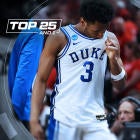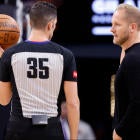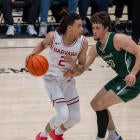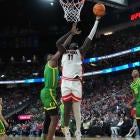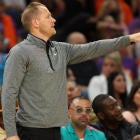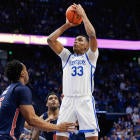This article is the third in a series of crash courses on Bracket Science. On Selection Sunday, CBSSports.com will produce its "Bracket Lab" to help people with their tournament picks. The tool's historical information comes from a database that I've put together on the 28 years of the 64-team tourney era. These blog posts are intended to make it easier for you to work with the Bracket Lab once the 2013 field is set.
In the first course, we learned about the concept of PASE, or performance against seed expectations. PASE is like baseball's WAR metric, comparing performance to the average wins of a "replacement" seed. In the second course, we used PASE to identify the top five overachieving coaches and teams and also ranked the top 10 attributes that signal over-performance in the tourney.
This week, instead of identifying the types of teams that could make surprise runs in the tournament, we're going to look at the characteristics that disqualify high seeds from reaching the Final Four. I'm restricting this analysis to the Nos. 1, 2 and 3 seeds because they've made up nearly 80 percent of the semifinalists since the tournament expanded to 64 teams in 1985. Of the 112 Final Four teams of the last 28 years, 85 of them (76 percent) have been among the top three seeds. Not only that, but these seeds have accounted for 25 of the 28 champions.
If you separate the teams that make the Final Four from those that don't at each of the top three seed positions, you'll find that the pretenders tend to share attributes that the contenders don't possess. Let's look at the Nos. 1, 2 and 3 seeds individually and identify the statistical signs that point to a bracket breakdown before the Final Four.
Eight signs of No. 1 seed pretenders
Top seeds are by far the most successful teams in the tournament. More than 40 percent of them -- 46 of 112 -- reach the Final Four. Of course, that means there are 66 No. 1 seeds that fall by the wayside before the last weekend of the dance. Beware of top seeds with any one of these telltale pretender attributes:
- A scoring margin of 10.5 points or fewer per game
- Imbalanced scoring, with more than 73 percent of points from either the backcourt or frontcourt (forwards and centers)
- A strength of schedule ranked higher than 80
- A "snake-bitten" coach (more than four tourney trips without an Elite Eight run)
- A coach with fewer than seven tourney appearances leading a team either without an All-American or that didn't go to the previous dance.
- A combined rebounding and turnover margin worse than five possessions a game
- An assist/field-goal ratio higher than 66 percent (signaling the lack of a "go-to" guy)
- A Pythag ranking worse than fifth, suggesting an over-seeded team
Only one of 37 top seeds possessing any of these attributes has managed to reach the Final Four. The lone exception was Texas in 2003. Coach Rick Barnes had been to the dance 11 times without making an Elite Eight run. Top seeds that aren't hampered by any of these weaknesses are 45-for-75 in reaching the Final Four. That works out to a 60-percent success rate -- and these teams also own an impressive +.532 PASE. Compare that to the pretenders, who fall short of seed expectations by more than a game per tourney (-1.078 PASE).
A 60-percent success rate in reaching the Final Four is 46 percent better than the typical 41-percent advancement rate of top seeds. Perhaps more importantly, these exclusion factors identify 45 of the 46 actual contenders.
Ten signs of a No. 2-seed pretender
Since 1985, 25 of the 112 No. 2 seeds have made it to the semifinals. That works out to a 22-percent Final Four advancement rate. How can you separate the second-seeded contenders from the pretenders? Cast a cold eye on any No. 2 seed with one or more of these 10 characteristics:
- A coach who has been to the tourney fewer than four times
- A winning percentage less than .765 or more than .900
- Fewer than six wins in the last 10 pre-tourney games
- A scoring defense allowing fewer than 56.9 points a game
- A scoring margin fewer than 8.8 or more than 18.4 points a game
- A strength of schedule ranked softer than 40
- A rebounding margin of fewer than two boards per game
- A combined rebounding/turnover margin of three possessions or fewer per game
- An assist-to-field goal percentage of 51 percent or lower
- More than one freshman starter or three senior starters
No. 2 seeds that possess any of these qualities are an astounding 0-for-62 in their quest to reach the Final Four, and their PASE is a woeful -.758. On the other hand, No. 2 seeds without any of these warning signs are 25-for-50 in getting to the last weekend of the dance. And they overachieve at a rate of almost a game per tourney (+.940 PASE). This 50-percent Final Four advancement rate is more than twice as good as the typical 22-percent success rate of second-seeded squads in reaching the semifinals.
Fourteen signs of No. 3 seed pretenders
Only 14 of 112 No. 3 seeds have reached the Final Four in the 64-team bracket era. That's just a 12.5-percent success rate. How can you spot one of the 98 No. 3-seed pretenders? Beware of any team with one of these 14 attributes:
- A Mid-Major without an All-American
- A rookie tourney coach leading a team that didn't go to the previous dance
- A snake-bitten coach with more than four dances and no Elite Eight runs leading a team with fewer than four straight bids
- Fewer than six or more than eight wins in the last 10 pre-tourney games
- A pre-dance losing streak of two or more
- A scoring average lower than 73 points per game
- A points-against average lower than 64 points per game
- A scoring margin under seven points per game
- A starting unit that gets less than 72 percent of the points
- A backcourt that gets more than 72 percent of the points
- A rebounding margin of fewer than three boards a game
- A turnover margin favoring the opponent by more than one turnover
- A strength of schedule ranked softer than 66
- Less than 29 percent of field goals attempted beyond the 3-point line
No. 3 seeds with any of these qualities are a dismal 1-for-73 in reaching the Final Four. The only team to defy the odds was Rick Majerus' Utah Utes in 1998. Meanwhile, No. 3 seeds without any disqualifiers are 13-for-39 in getting to the final weekend of the dance. That's a 1-in-3 advancement rate -- nearly three times better than the overall 1-in-8 rate for No. 3 seeds.
Separating high-seed contenders from pretenders: the overall impact
All told, the top three seeds in the tourney have had a 25-percent success rate in reaching the Final Four (85-for-336, 25.3 percent). But teams with any of the pretender characteristics cited above are just a measly 2-for-172 -- 1.2 percent proficient -- in getting to the semifinals. If you eliminated those teams from consideration in your bracket pondering, the rest of the Nos. 1-3 seeds are 83-of-164 in hanging around to the last weekend of the dance. That's better than a 50/50 success rate -- and twice as good as the typical rate of the top three seeds.
For the last five years, I've filled out a bracket model that starts with this seed-by-seed "contender/pretender" method for identifying Final Four candidates. That model contemplates the top eight seeds. After identifying the Final Four candidates, I then use a second analysis to narrow down on my ultimate semifinalists. The model has performed in the 85th percentile of the tourney challenge contests run by major sports sites. Some years, like 2009 (97th percentile) and 2010 (98th percentile), it would've been in the running to win an average-sized pool. Other years, like last year (62nd percentile), it wouldn't have done so well.
After Selection Sunday, I'll post the bracket that this methodology yields, along with two other stats-based bracket models. I'm never one to crutch exclusively on what the numbers say come tournament time -- largely because even the best approach to picking your bracket is a low-probability proposition. But it's always good to know what the historical data says about how the bracket will play out, if for no other reason than to be aware of when you're taking a big risk.











